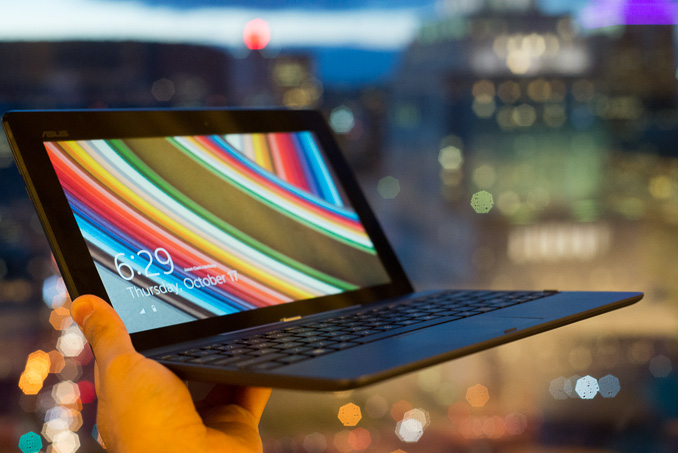ASUS Transformer Book T100 Review: Redefining the Entry-Level Windows Notebook
by Anand Lal Shimpi on October 18, 2013 12:00 AM ESTFinal Words
It’s tough to sell an entry-level Windows PC these days. You’re sandwiched between a couple of aggressive price points: the Nexus 7 at $229 and the iPad at $499. Traditionally, the PC you’d get between those price points would have mechanical storage, the cheapest of cheap TN panels, be bulky as possible, an unimpressive keyboard/trackpad and have 2.4GHz-only WiFi. About the only solace would be that it’d have some insanely quick Core architecture CPU inside, which more or less didn’t matter since the overall experience was hampered so much by the spinning disk inside. Thankfully, times are changing.
Assault first and foremost comes from Google’s latest lineup of Chromebooks. The HP Chromebook 11 addresses many of these concerns but with a fairly limited OS and silicon that’s honestly a bit too slow, even for the target market. But you do get an awesome keyboard, eMMC based storage, and an IPS panel among other things.
The Transformer Book T100 is really the Wintel camp’s answer to the Chromebook onslaught. Compared to the traditional entry-level PCs out there, the T100 really is a breath of fresh air. You get an IPS panel, great battery life and modern WiFi all in a package that can work as both a notebook and a tablet. The system is responsive and predictable in its performance thanks to the use of solid state storage. While there isn’t a full blown SSD inside, the eMMC solution is clearly better for light consumer workloads than a mechanical disk. Solid performance from the rear facing speakers and excellent portability round out the T100’s package. If I had to compare it to what you’d normally expect to get from a $349/$399 Windows PC, I’d say the Transformer Book T100 is a clear winner.
Where things get complicated is if/when you start comparing across platforms. ASUS and Google set the standard for affordable color calibrated displays with the 2013 Nexus 7, and unfortunately the T100 comes no where close to that. Even HP’s Chromebook 11 delivers a more accurate out of box experience than the T100. Again, the T100’s display isn’t bad, it just desperately needs a factory calibration.
It’s important to keep the T100’s performance in perspective. For light multitasking or single app-use workloads, the T100 does very well (much better than the Chromebook 11 we just reviewed). Light browsing and document work are at home on the T100. Don’t expect it to be a Haswell replacement though. I would like to see the gap narrow between Intel’s Atom and Core lines, but I’m afraid it’s going to take real performance pressure from a competitor before we ever see that day.
The dock experience on the T100 is reasonable, but it’s clear to me that the Transformer Book T100 is first and foremost a tablet, and only serves as a clamshell device as a secondary function. That’s not to say it makes for a bad notebook experience, it can just be cramped as a result of the 10.1-inch display footprint. If you’re looking for a device that you’ll use mostly as a tablet but want the flexibility of turning it into a notebook when you need to, the T100 can definitely fit the bill. If your desire is primarily for a touchscreen notebook, then the T100’s tradeoffs may be more frustrating.
At the end of the day the T100 is a good device, but like the Chromebook 11 we recently reviewed it could’ve been amazing with a few tweaks. With a less reflective display, color calibration at the factory and a better feeling keyboard/trackpad I’d be absolutely in love with the T100. I also wonder if 10.1-inches is the right form factor for this sort of a device. I’m not sure that Microsoft’s decision to go with 10.6-inches is the right one either, but the typing experience on a Surface’s type/touch covers does feel remarkably less cramped.
The T100 truly lives up to the Transformer brand. The combination of Intel's Bay Trail silicon and ASUS' mechanicals gives the device a dual personality. In tablet mode it's just as portable as any other 10-inch tablet, while in clamshell mode it can be a netbook-style ultraportable PC. I’d love to see ASUS continue down this path and truly try to perfect the device. I look at the work that ASUS and Google do together and can’t help but wonder what the T100 would look like if it had the same sort of pressure/influence. Perhaps that’s a bigger criticism of how Microsoft works with its partners, but I look at the comparison of ASUS tablets with and without Google’s influence and try to imagine a further polished Transformer Book. That’s something I’d really like to see.
There are very few perfect computing devices out there, but ASUS is one of the companies with the ability to build one if it really tries.












158 Comments
View All Comments
damianrobertjones - Sunday, October 20, 2013 - link
I cannot believe how many times the HP Chromebook 11 is mentioned in this article! It's being pushed onto the consumer HARD.azazel1024 - Sunday, October 20, 2013 - link
Can anyone confirm if the micro USB port on the tablet is for charging only? Or does it support full USB host when not used for charging? A couple of early preview/product announcements indicated it could be used for both, but Anand and Lilliputings both mention the port is to charge the tablet and me ting no USB host functionality one way or another.It would be kind of sad if it can't be used for both.
marcosv - Saturday, October 26, 2013 - link
Just received my T100.The micro USB port on the tablet itself is indeed a USB host port. Just use the appropriate OTG adapter. For charging, the tablet senses the pullup resistor in order to charge at 2A, and so needs the appropriate charger or charging cable, just like the Nexus 7.
flyingpants1 - Monday, October 21, 2013 - link
This will obsolete A LOT of old computers, especially on the used market, why pay $150-200 for a refurbished, possibly half-broken desktop or laptop when you can probably get one of these for <$300 on sale.074geodude - Monday, October 21, 2013 - link
Asus *almost* got it right. So close to perfection, but their penny-pinching ways had to ruin it.Atom Z3770 and 4 GB of RAM would have made this a clear winner. I don't think people would have minded paying an extra $50 or so for a faster processor and more RAM.
Maybe next year Asus...
Belldandy - Tuesday, October 22, 2013 - link
I think the real issue is with Microsoft: "Intel's silicon in the T100 is 64-bit capable but Microsoft still lacks a 64-bit version of Windows 8/8.1 with Connected Standby enabled." Running more than 3GB ram on 32 bit windows is a waste, and Asus chose for sync memory speeds at the same time as lower cost to have Connected Standby enabled to compete with the Androids and Ipad's wake and remain connected.azazel1024 - Monday, October 21, 2013 - link
I agree, only to the extent that I would gladly pay the extra for those bits.It seems "good enough" for me. Its cheap enough that if/when more compelling hardware comes out, maybe next year, with Airmont architecture that I don't mind the cost in selling off a T100 and getting the next new thing.
I am still crossing my fingers that before I pull the trigger around the holidays that Asus will come out with a T200 with the z3770 and more memory in it (and maybe a slightly nicer display?)
Dracoon - Tuesday, October 22, 2013 - link
Hi, could you please test the wifi range?markc22 - Tuesday, October 22, 2013 - link
I want to see more tests against Clover Trail.azazel1024 - Friday, October 25, 2013 - link
So, are there going to be any updates to the article or an addendum article at some point?Its great that you got the review out so fast/before anyone else. However, it seems to be lacking some of the things you often do in reviews, like test the Wifi performance and a full battery life test. I did notice in the Surface review you seem to have done a movie battery life test.
It would also be nice to see some more performance benchmarks against some older hardware (if that is even possible).
With them, if possible, can you conduct one with and without the dock attached? That dock is going to be using some amount of power compared to just tablet only. Just curious if it makes any real impact.